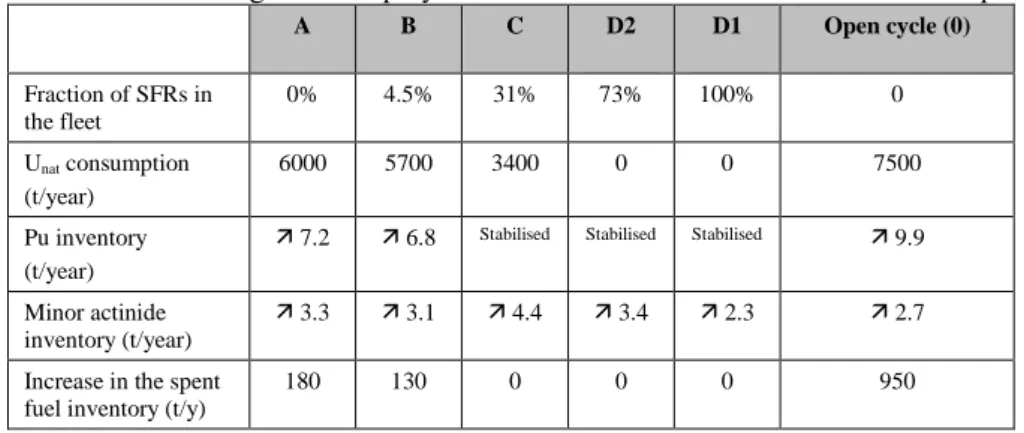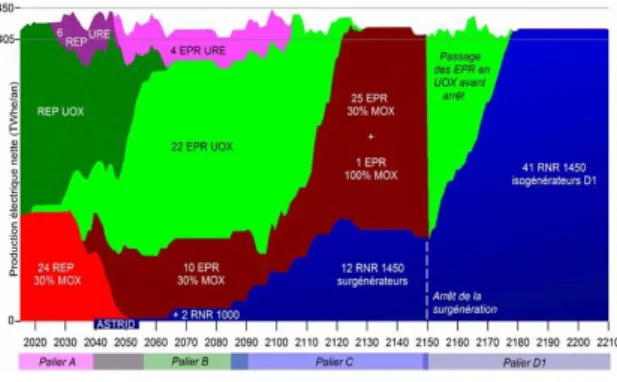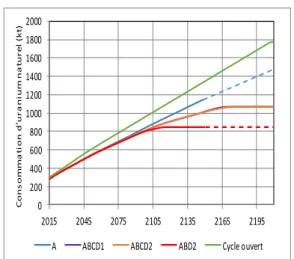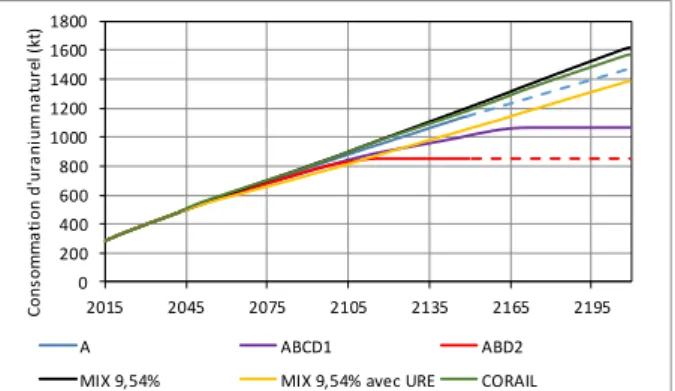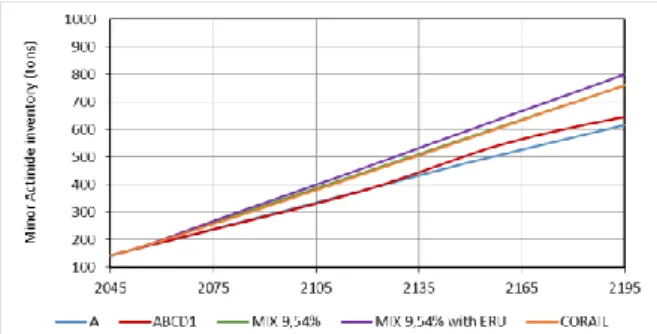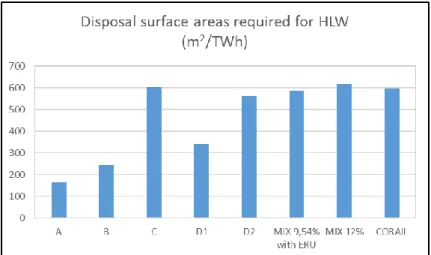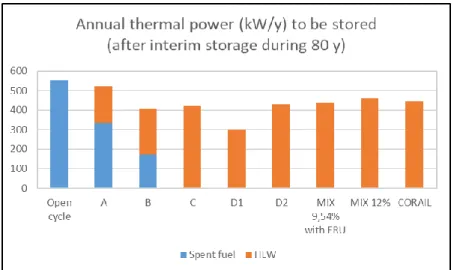HAL Id: cea-02614134
https://hal-cea.archives-ouvertes.fr/cea-02614134
Submitted on 20 May 2020
HAL is a multi-disciplinary open access
archive for the deposit and dissemination of
sci-entific research documents, whether they are
pub-lished or not. The documents may come from
teaching and research institutions in France or
abroad, or from public or private research centers.
L’archive ouverte pluridisciplinaire HAL, est
destinée au dépôt et à la diffusion de documents
scientifiques de niveau recherche, publiés ou non,
émanant des établissements d’enseignement et de
recherche français ou étrangers, des laboratoires
publics ou privés.
Prospective inventory of radioactive materials and waste
produced by the French nuclear fleet according to
various options
C. Chabert, E. Touron, A. Saturnin, G. Krivtchik, J.-L. Girotto, G.
Mathonnière, R. Eschback, S. Gabriel, G. Martin, P. Miranda, et al.
To cite this version:
C. Chabert, E. Touron, A. Saturnin, G. Krivtchik, J.-L. Girotto, et al.. Prospective inventory of
radioactive materials and waste produced by the French nuclear fleet according to various options.
Global/Top Fuel 2019, Sep 2019, Seattle, United States. �cea-02614134�
PROSPECTIVE INVENTORY OF RADIOACTIVE MATERIALS AND WASTE PRODUCED BY THE FRENCH NUCLEAR FLEET ACCORDING TO VARIOUS OPTIONS
C. Chaberta*, E. Touronb, A. Saturninb, G. Krivtchika, G. Martina, Ph. Mirandaa, F. Courtina, JL. Girottob, G. Mathonnièreb, S. Gabrielb, R. Eschbacka, A. Alloua, R. Boccaccioa, FX. Giffardb,
A. Boninb, P. Casolib, F. Laugiere , B. Carlierc, G. Senentzd, aCEA, DEN, Cadarache, DER, F-13108 Saint-Paul-Lez-Durance, France
bCEA, DEN, Marcoule and Saclay
cFramatome, dOrano, eEDF
*christine.chabert@cea.fr
In accordance with the French Act of 28 June 2006 on the sustainable management of radioactive materials and waste, this paper summarises the technical characterisation of prospective scenarios using different fuel cycle options: open cycle, recycling of plutonium and uranium in PWRs (current option for the French nuclear power fleet), multiple recycling of plutonium in SFRs, and multiple recycling of plutonium in PWRs. This information has been submitted by the CEA to the Ministry of Energy within the scope of Article 51 of the Ministerial Order dated 23 February on the French National Radioactive Materials and Waste Management Plan (PNGMDR) [Ref. 1].
Rather than imagining the large-scale replacement of PWRs by fast reactors within a short period of time (the assumption of some past studies), it was decided to study a scenario involving a more progressive deployment on the basis of existing materials and facilities. This solution appears to be better suited to the dynamics of technical progress in the field, while providing greater flexibility to adapt to societal changes. The path for this scenario is marked by successive milestones (stages), with each corresponding to an increased deployment of fast reactors with their own increasingly ambitious objectives.
Phase A corresponds to the current state of the French nuclear reactor fleet wherein plutonium and uranium are recycled in mixed-oxide (MOX) and enriched reprocessed uranium (ERU) fuels in pressurised water reactors (PWR). Phase B consists in recycling spent MOX fuel from PWRs in a limited number of SFRs. The objective of this phase is to stabilise the quantities of spent MOX fuels from light water reactors. Phase C is designed to be able to stabilise the plutonium inventory by deploying a symbiotic fleet comprising UOX-PWRs, MOX-PWRs and SFRs. The objective of phase D is to deploy a fleet of reactors that no longer burns natural uranium. There are two possible options for a nuclear fleet that can generally be considered as self-sufficient, i.e. D1, a homogeneous fleet with 100% SFRs, and D2, a mixed fleet comprising breeder SFRs producing plutonium and PWRs fuelled with 100% MOX to burn this plutonium.
However, SFRs may not become economically competitive in the next few decades if uranium resources remain readily available, and MOX spent fuels may start to pile up at the back-end of the fuel cycle unless alternative plutonium management solutions in PWRs are found. In this study, advanced fuel batches, called CORAIL and MIX, are applied to enable multiple recycling in standard PWRs.
The CORAIL concept involves placing both MOX fuel rods with depleted uranium support structures and UOX fuel rods in the same fuel assembly. A configuration based on 84 MOX fuel rods and 181 UOX fuel rods was studied in the early 2000s, which is why it has been chosen for the first scenario in this paper. As the enrichment of UOX rods is maximised at 5%, the plutonium content is adapted to make up for its loss of fissile quality with each recycling phase.
The MIX concept is based on a fuel assembly containing only MOX fuel rods with enriched uranium support structures. The purpose in this case is to limit the plutonium content in the fuel to a level similar to that of current MOX fuels and to meet any additional needs in fissile nuclei by providing enriched uranium in the support. The greater the isotopic degradation of plutonium, the greater the enrichment will be, which will be increased with each recycling phase to make sure 235U is stabilised at around 3% to 4%. Three plutonium
contents have been considered in our study: 8%, 9.54% and 12%.
This paper assesses the material flows and inventories for these various options on the basis of two approaches: 1) static (or in equilibrium) by supposing that each option is artificially maintained long enough, and 2) dynamic (for transition scenarios).
The total disposal surface area required for each of the different options is also discussed on the basis of the Andra disposal concept. The assessment of the resulting waste volumes depending on the option is given in another paper, also presented at this conference [Ref. 2].
I. TECHNICAL PERFORMANCE OF THE
FUEL CYCLE OPTIONS - STATIC
APPROACH
All the cases studied in this paper are based on the assumption of a nuclear reactor fleet generating about 430 TWe/y. Table I summarises the main characteristics of the options involving the progressive deployment of SFRs up to the fuel cycle closure option (D2 and D1). The characteristics in the table confirm that the gradual transition from phase A through to phase D would lead to improvements - with each phase - in the sustainable management of materials, particularly in the consumption of natural uranium (additional savings of 5% between phase A and phase B, and around 43% between B and C, before reaching 100% in phase D). Spent PWR-MOX and ERU in storage can be recycled and thus optimised, which simultaneously stabilises the inventories of all the spent fuels regardless of their type. This confirms the relevance of such a progressive approach, which also makes it possible to improve the industrial maturity of SFRs and the related fuel cycle with each phase, even though its integration in the second half of this century remains relatively small. The information used to compare the technical characteristics of the scenarios using the MIX and
CORAIL concepts is given in Table II, including data on phase A, phase D1 (100% SFRs) and the open fuel cycle (phase 0).
By integrating about 30% of MIX PWRs or 87% CORAIL-2000 PWRs into the fleet, it is theoretically possible to start up MIX or CORAIL fleets to achieve a balance in the material flows within a period of about forty years and to ‘absorb’ the spent MOX and ERU inventories. These scenarios make it possible to practically stabilise the spent fuel and plutonium inventories at a level between 600 and 700 tonnes.
These concepts can lead to additional savings in uranium resources up to about 10% compared with the current once-through recycling (for a total exceeding 25% compared with an open fuel cycle) in a configuration where reprocessed uranium is recycled. It is therefore possible to stabilise the reprocessed uranium and ERU inventories in a fleet equipped with MIX PWRs thanks to the implementation of ERU PWR management strategies in non-mixed reactors and through spent ERU recycling.
The MIX/ CORAIL concepts lead to an increased production of minor actinides in all reactor systems, fuel cycle plants and storage outlets (by about +30% in the scenario investigated compared with once-through recycling, or by about +100% compared with a 100% SFR fleet).
TABLE I: Progressive deployment of SFRs - Main characteristics for each phase
A B C D2 D1 Open cycle (0) Fraction of SFRs in the fleet 0% 4.5% 31% 73% 100% 0 Unat consumption (t/year) 6000 5700 3400 0 0 7500 Pu inventory (t/year)
7.2 6.8 Stabilised Stabilised Stabilised 9.9 Minor actinide
inventory (t/year)
3.3 3.1 4.4 3.4 2.3 2.7 Increase in the spent
fuel inventory (t/y)
180 130 0 0 0 950
TABLE II: Multiple recycling of Pu in PWRs - Main characteristics for each phase
A CORAIL MIX 9.54% with ERU management MIX 9.54% without ERU management D1 Open cycle (0) Fraction of MIX/CORAIL or SFRs in the fleet 0% 87% 35% 35% 100% 0
Unat consumption (t/year) 6000 6300 5500 6900 0 7500
Pu inventory (t/year) 7.2 Stabilised Stabilised Stabilised Stabilised 9.9 Minor actinide inventory (t/year) 3.3 4.2 4.5 4.2 2.3 2.7
II. FUEL CYCLE TRANSITION SCENARIOS
Two types of transitional scenarios have been chosen and compared. In all cases, the initial conditions applied are those that currently exist in France, i.e. once-through recycling of Pu in PWRs (phase A).
o Scenarios involving the progressive deployment of SFRs
- Scenario ABCD1 involves the successive deployment of all phases, starting with phase A (once-through recycling of Pu in PWRs), then phase B (stabilisation of spent PWR MOX by recycling in a few SFRs), followed by phase C (stabilisation of the Pu inventory using a symbiotic PWR-SFR fleet), and finally phase D1 (100% SFR fleet).
- Scenario ABCD2 ends with a hybrid fleet comprising SFRs and 100% MOX PWRs - Scenario ABD2 is an alternative to scenario
ABCD2 where deployment of D2 is accelerated (this scenario could apply in the case where the price of natural uranium rises rapidly or there is a shortage of natural uranium).
o Scenarios involving the multiple recycling of Pu in PWRs
- Scenarios implementing the MIX concept for the multiple recycling of Pu until its total inventory has stabilised. Three alternatives have been defined according to the acceptable Pu concentration in the fuel: 8%, 9.54%1 and 12%. We also investigated a MIX scenario based on the recycling of reprocessed uranium through the management of ERU PWRs.
- The scenario implementing the CORAIL concept for the multiple recycling of Pu until its total inventory has stabilised.
II.A. Scenarios involving the progressive deployment of SFRs
The transition from phase A to phase B corresponds to the implementation of spent PWR MOX fuel treatment and to the deployment of the first SFR units required to use the plutonium resulting from this treatment. The start-up of commercial SFRs is expected occur 25 years after the industrial commissioning of the Astrid-600 MW reactor (assumed in this study to be in 2039), i.e. in the mid-2060s. This timescale takes into account the
1 The Pu concentration of 9.54% corresponds to the
“MOX parity” management strategy that EDF asked the French regulator to examine. The regulator accepted a Pu concentration of 9.08% in the end, which is sufficient for the management of MOX fuels in the coming years.
need for sufficient feedback from the operation of Astrid and for realistic lead times for technical and regulatory actions. The chosen reference option consists of directly including Astrid in the objective of stabilising the spent MOX fuels in phase B. In this case, phase B assumes the deployment of 2 SFRs in addition to the demonstrator. These are paired, enabling additional savings to be made on the cost of these 2 reactors. Phase C starts with the implementation of spent SFR fuel processing from the first commercial units deployed in phase B and the deployment of additional SFRs to recycle the plutonium that has been recovered. It was decided in the study to start the phase by 2090, a date which corresponds to a period of deployment of new reactors and coincides with the renewal of the fuel cycle facilities, the lifetime of which is assumed to be 50 years in this study. The transition from C to D will occur during a period of renewal of the fleet, i.e. between 2150 and 2180. An accelerated transition from B to D has also been characterised, enabling the assessment of issues which could be encountered in the event of early tension on uranium prices. The scenario in this case envisages the transition to D by 2090.
An example of the changing composition of the fleet over time is given in Figure 1 for transitional scenario ABCD1.
Fig. 1: Changing composition of the fleet for transitional scenario ABCD1
Figure 2 shows that the cumulative consumption of natural uranium stabilises faster for scenarios with an accelerated transition to SFRs: ~1065 kt for scenarios ABCD1 and ABCD2 in comparison with ~850 kt for scenario ABD2, giving a saving of around 20%. In fact, the transition to phase C which implements the management of PWRs loaded with UOX and partly with MOX (30%) is avoided. Independence with respect to natural uranium is thus accelerated. However, the cumulative consumption of natural uranium continues to rise for a French fleet that continues to operate with the once-through recycling of Pu in the form of PWR MOX fuels (Scenario A).
Figure 2: Cumulative consumption of natural uranium (kt) for the SFR deployment scenarios and
comparison with the scenarios involving once-through recycling and the open cycle These scenarios achieve the objective of stabilising the plutonium inventory at a value close to 1200 tonnes (Figure 3). Conversely, the overall plutonium inventory continues to increase linearly in the case of the open cycle scenario, or at a slower rate during once-through recycling of Pu in PWRs (Scenario A continuing the current situation). Accelerated transition scenario ABD2 stabilises the Pu inventory from 2120 on.
Figure 3: Variation in the overall Pu inventory (tons) for the SFR deployment scenarios All the SFR deployment scenarios stabilise the storage of spent fuels, unlike the option of continuing with the current situation (Scenario A) for which the spent fuel inventories continue to increase, albeit much less quickly than in the context of an open cycle (Fig. 4). It should therefore be noted that in 2200 for example, the extension of the current situation would lead to accumulating around 57,000 t of spent fuel, comprising: 45,000 t of UOX and ERU plus 12,000 t of MOX. For the open cycle, it would lead within the same timescale to accumulating around 220,000 t of spent UOX fuel.
Figure 4: Variation in the interim storage of spent fuel for the transitional scenarios (kt)
II.B. Scenarios involving the multiple recycling of Pu in PWRs
The scenarios implementing the MIX and CORAIL concepts have been established using the same assumptions as those for the SFR deployment scenarios with regard to the description of the current PWR fleet and its renewal. It should be remembered that the CORAIL concept used here is the one studied in the early 2000s and that the concept is currently being optimised by Framatome. It has not been possible to assess the optimised version for this study.
In addition, although this point needs to be consolidated by additional studies, it has been considered that the industrial deployment of these concepts would be theoretically possible in 2045, a timescale that seems at this stage in the studies to be reasonable for commissioning new fuel cycle plants and qualification of these new fuel products. These transitional scenarios have been defined so as to reveal and test the capacity of these concepts for multi-recycling and using the existing spent fuel inventories. To do this, the following principles are applied: recycling of all the spent MOX fuel stocks as quickly as possible, then stabilisation of the plutonium inventory and all the spent fuel inventories. Once all the spent MOX fuel has been recycled, the spent MIX and CORAIL fuel is reprocessed.
On a preliminary basis, a joint plutonium and reprocessed uranium multi-recycling scenario was established in order to measure its feasibility (MIX scenario including management of ERU PWRs). An example of a timescale for the deployment of reactors for the MIX scenario including management of ERU EPRs is given in Figure 5. The number of MIX PWRs deployed to achieve
0 200 400 600 800 1000 1200 1400 1600 1800 2000 2015 2045 2075 2105 2135 2165 2195 C o n s o m m a ti o n d 'u r a n iu m n a tu r e l (k t)
A ABCD1 ABCD2 ABD2 Cycle ouvert
200 400 600 800 1000 1200 1400 1600 1800 2000 2200 2400 2015 2045 2075 2105 2135 2165 2195 In ve n ta ir e en p lu to n iu m (t )
Cycle Ouvert (0) A ABCD1 ABCD2 ABD2
0 10 20 30 40 50 60 70 80 2015 2045 2075 2105 2135 2165 2195 sp en t fu el in ven to ry ( kt ) A ABCD1 ABCD2 ABD2 Open cycle
stabilisation of the Pu inventory depends on the plutonium content chosen in the concept. Thus the higher the content, the more the plutonium consumption in the MIX reactor increases and the fewer reactors with MIX fuel need to be introduced into the fleet to compensate for the Pu production in the reactors loaded with UOX fuel. The rate of incorporating MIX in the fleet thus varies between 29% and 37% according to the Pu content being considered (between 12% and 8%). It should be noted that the assumption is made in these studies that the MIX or CORAIL reactors are started up with cores completely loaded with these fuels (no simulated start-up cores). A large proportion of the Pu is therefore mobilised to supply these reactors, and the management of MOX PWRs is then stopped.
Figure 5: Variation in the composition of the fleet for the 9.54% MIX scenario with ERU management Figure 6 shows the cumulative consumption of natural uranium for the different scenarios; it can be seen that self-sufficiency with respect to natural uranium can only be achieved by opting for the closed fuel cycle, i.e. deployment of SFRs.
The consumption of natural uranium in the 12% MIX scenario (6700 tonnes/year) is lower compared with the 8% MIX scenario (7000 tonnes/ year). Degradation in the fissile quality of Pu caused by its successive recycling is compensated by its enrichment in 235U using an enriched support structure. When the Pu content in the MIX fuel increases, the need for 235U enrichment to maintain the required cycle length therefore decreases. Compared with scenario A, the consumption of natural uranium in the MIX scenarios without ERU management is always higher by about 10 to 15% depending on the Pu content. The sharp decrease in the neutron flux in the thermal range because of the plutonium isotopes in the MIX fuel deteriorates the efficiency of 235U which, in turn, is less likely to fission. The 235U content found in a MIX fuel at unloading is about 2% compared with 0.8% for an
irradiated standard UOX fuel. This reprocessed uranium with excellent fissile properties therefore needs to be recycled in order to efficiently manage the uranium resources. Any remaining uranium should thus be recycled in MIX and UOX fuels through ERU PWR management strategies in order to reduce the consumption of natural uranium compared with scenario A wherein the current situation is continued. Additional savings in natural uranium of about 9% can be made for a total of 25 to 30% compared with an open fuel cycle.
Figure 6: Consumption of natural uranium (kt) in the MIX and CORAIL scenarios compared with
scenarios A, ABD2 and ABCD1
The main objective of these scenarios is to ‘absorb’ the spent MOX fuel inventories as quickly as possible so we can test and validate the capacity of the CORAIL and MIX concepts to optimise existing fuels. This objective can be reached by deploying the MIX scenarios for 15 years or the CORAIL scenario for 25 years on the condition that PWR MOX fuels are reprocessed at a much faster rate. The industrial feasibility of achieving such reprocessing rates during this period of time remains to be demonstrated. The additional 10 years for the CORAIL concept are due to the trade-off between maintaining a reasonable inventory of separated Pu and maintaining a nominal reprocessing capacity that reflects the equilibrium to be reached in the future.
The total plutonium inventories for the different scenarios become relatively stable from 2060 once the fleet has reached equilibrium. Achieving stability is the second most important objective of these Pu multiple recycling scenarios in a thermal fleet once all of the spent MOX fuel has been recycled. It is reached about 15 years after having deployed the first MIX or CORAIL management strategies in PWRs (2045). It can be seen that the Pu inventory can be stabilised with inventories ranging between 640 and 680 tonnes in 2100, for example, in contrast with the regular increase in the Pu inventory for scenario A (continuation of the current situation) which generates about 1000 tonnes at the same period in time. This Pu inventory
0 200 400 600 800 1000 1200 1400 1600 1800 2015 2045 2075 2105 2135 2165 2195 C o n so m m a ti o n d 'u ra n iu m n a tu re l ( kt ) A ABCD1 ABD2
is highly concentrated in spent fuels (representing about 55%).
Figure 7 shows the evolving inventory of minor actinides for the MIX and CORAIL scenarios before making a comparison with the minor actinide inventories for scenarios A and ABCD1.
Figure 7: Minor actinide inventory (tons) for the MIX and CORAIL scenarios compared with
scenarios A and ABCD1
The increased production of minor actinides due to the implementation of ERU management strategies in a mixed fleet is mostly due to neptunium. The 236U contained in ERU fuel leads to a strong increase in the production of 237Np under irradiation. The composition of the minor actinide inventory in Pu multiple recycling scenarios in PWRs is similar to that of scenarios involving the deployment of SFRs, i.e. 27.5% Np, 70% Am and 2.5% Cm. Nevertheless, MIX and CORAIL fleets will generate more minor actinides than SFR fleets, as shown in Figure 7. This difference can be explained by the fact that the fissile quality of plutonium deteriorates with each recycling in the MIX and CORAIL configurations, and by the behaviour of plutonium isotopes with even numbers of protons which are neutron absorbers in the thermal spectrum. From an isotopic perspective, an increase in the production of 243Am has been detected in these concepts which is closely related to the high proportion of 242Pu produced. Curium-244 is produced by neutron reactions with 243Am, therefore resulting in an increase in the level of curium. Minor actinides are mainly found in vitrified waste packages.
III. DISPOSAL SURFACE AREAS
REQUIRED FOR THE DIFFERENT FUEL CYCLE OPTIONS
The waste disposal surface area required for the different options has been assessed in terms of the thermo-hydro mechanical (THM) and thermal design criteria (90°C on waste package surfaces) relying on data provided by Andra. This study also includes cases wherein the spent fuel is placed directly in disposal. However, the study on the possible direct disposal of non-reprocessed spent
fuel is not sufficiently advanced for our current assessment. This is particularly true with respect to assessing the underground disposal surface area requirements for large volumes of spent fuel with high decay heat releases. This restricts the results of our study with respect to scenarios involving the direct disposal of spent fuel.
Nevertheless, the disposal surface area required for high-level waste (vitrified waste packages) has been fully assessed, and the results for all fuel cycle options (once-through, twice-through recycling and multiple recycling in PWRs, and multiple recycling in SFRs) are reported in this paper. This study does not pre-empt the location of the disposal site for the waste considered. However, we did assume that the deep geological repository was located in clayey rock similar to the layer of argillaceous rock studied in the Meuse/ Haute-Marne region for the Cigéo project. This assumption allowed us to base our concepts on the knowledge collected from the project.
Sensitivity analyses were also conducted:
- Duration of interim storage: a period of 80 years was chosen as the reference. A 5% reduction in the surface area required is possible if this storage period is extended to 100 years.
- Depth of the clayey rock: a reference depth of -550 m was chosen. A 5% reduction in the surface area required is possible if this depth is increased by 30 m.
- Parameters of the clayey rock (thermal conductivity, Young’s modulus and porosity): Applying the more favourable conditions of the Cigeo region leads to a reduction in the centre-to-centre distance between disposal cells by about 50%, i.e. a reduction in the surface area of the same order of magnitude.
The surface area required for HLW (vitrified packages) associated with phases A, B, C, D1, D2, MIX and CORAIL for a period of 60 years has been estimated for an interim storage period of 80 years (see Table III).
The smallest surface area for vitrified waste packages corresponds to phase A as the packages contain low levels of minor actinides (contribution of 241Am) and are therefore less problematic in terms of thermal releases. The surface area estimated for phase B is about 50% higher than that estimated for phase A. These preliminary results characterise the disposal conditions for vitrified waste to which spent fuel must be added (phase A in the case where there is no transition to the subsequent phases).
Option D1 requires a significantly smaller disposal area compared with the other phases involving multiple recycling. This is due to the lower flow of waste packages (about 40% less) thanks to the lower production of minor actinides in SFRs. Phases C and D2 require similar disposal surface areas owing to the importance of two input parameters, i.e. 1) annual flow of waste packages which is determined by the alpha particle limit on vitrified waste due to the increased levels of some minor actinide radioisotopes (241Am, 243Am and 244Cm), and 2) the thermal power which is mainly due to 241Am. These results are due to the higher quantity of minor actinides contained in the waste, which is due to the larger quantity of treated MOX fuel compared with other cases. These conclusions remain valid for the MIX and CORAIL phases which require disposal surface areas similar to those of phases C and D2; both these phases have a large proportion of PWR MOX fuel.
Though it has not been assessed in this study, a large quantity of spent fuel emitting high thermal
releases in phases 0, A and B will also require disposal and thus a large disposal surface area. At this stage of the study, we have only indicated the thermal power released over 80 years by the quantity of spent fuel produced in one year. It will be important to clarify the required disposal surface areas in subsequent studies carried out in collaboration with Andra (Figures 8, 9 and 10). These studies have shown that the thermal power of 241Am in practically all high-level waste categories for disposal (including 238Pu to a certain extent for spent fuel) is the predominant factor for estimating the required surface areas, considering the recent changes in the design criteria for clayey-type rock configurations and the thermo-hydro-mechanical criterion. We need to further investigate how spent fuel in storage should be processed so as to limit the production of 241Am through the radioactive decay of 241Pu during interim storage in order to optimise the surface area required for disposal.
Figure 8: Disposal surface areas required for HLW (m2/TWh)
Figure 10: Annual thermal power to be stored (kW/year)
IV. CONCLUSION
The main results of these studies can be summarised as follows:
Progressive deployment of SFRs with the multiple recycling of uranium and plutonium:
The characterisations provided herein confirm that transitioning from once-through recycling (current solution) to a closed fuel cycle improves the key parameters of a sustainable fuel cycle when the uranium market prices justify investing in an SFR fleet (natural uranium consumption, optimisation of spent MOX and ERU fuel, and production of final waste).
Multiple recycling of uranium and plutonium in PWRs:
The preliminary assessments of the MIX and CORAIL concepts show they are capable of recycling spent MOX and ERU fuel and of stabilising the spent fuel and plutonium inventories. Compared with the once-through recycling of uranium and plutonium, these concepts reduce the need for natural uranium when reprocessed uranium can be recycled, which in turn generates a saving over 25% in natural resources compared with an open fuel cycle. The production of minor actinides is increased by about 30% compared with once-through recycling. Among the different concepts discussed, CORAIL (MOX and UOX rods in the same fuel assembly) and MIX (MOX fuel on enriched uranium support structures) currently appear to be the most accessible considering the status of French knowledge in the field of once-through recycling in PWRs. Their deployment on a fleet-scale could be envisaged in 20 to 30 years’ time. At this stage, the preliminary studies have not revealed any unacceptable issues with reactor operation, but these results remain to be consolidated by additional engineering studies. For
deployment on a fleet scale, these concepts require reactors capable of handling MIX and CORAIL fuels, with the number of these reactors varying depending on the concept and fuel assembly configuration chosen, e.g. 30% of the fleet for a MIX management strategy. They also require new fuel cycle plants, particularly facilities capable of managing the increased plutonium levels.
In the case of a transitional scenario between the current once-through recycling solution and the full deployment of SFRs, the option of being able to implement multiple recycling in PWRs would give us time to improve the processes and industrial maturity of the fuel cycle plants needed for SFRs, considering that equilibrium in the annual plutonium and MOX fuel flows occurs somewhere between the flows needed for once-through recycling and those expected to be required for an SFR fleet.
Multiple recycling in PWRs deteriorates the fissile quality of plutonium which is currently stored as a resource for the deployment of SFRs (e.g. about 45% 239Pu + 241Pu for the MIX concept at equilibrium, compared with about 50% for spent MOX fuel and a little more than 60% for spent UOX fuel). It would be possible to stabilise or even reduce the plutonium inventory with a multiple recycling solution.
It should be pointed out that the technical performance (i.e. savings in natural uranium resources and reduced waste production) of multiple recycling in PWRs is much lower than that achieved by fast reactors, which remain the most relevant choice for a closed fuel cycle. How complex the PWR fuel cycle becomes by implementing multiple recycling instead of once-through recycling must also be assessed in terms of the refined flows of recycled materials, the detailed analysis of the industrial feasibility, and the technical progress required for its implementation in the reactors and fuel cycle plants.
Waste disposal surface areas:
The waste disposal surface areas have mainly been assessed on the basis of the thermo-hydro-mechanical criterion in collaboration with Andra. At this stage of the study, only the disposal surface area required for vitrified waste packages has been assessed for the different options. These results highlight the relevance of using a closed fuel cycle to reduce the surface area required for waste disposal, it being understood that there would no longer be any spent fuel in disposal, contrary to phases A and B. These assessments are still ongoing in collaboration with Andra.
ACKNOWLEDGMENTS
The authors are grateful to EDF, Orano and Framatome for their support on this work through the CEA research programme on the back-end of the fuel cycle.
They would also like to thank Andra for its help in assessing the impact of the different fuel cycle options on waste disposal.
REFERENCES
1. French National Plan for the Management of Radioactive Materials and Waste 2016-2018,
http://www.french-nuclear- safety.fr/Information/Publications/Others- ASN-reports/French-National-Plan-for-the- Management-of-Radioactive-Materials-and-Waste-for-2016-2018
2. A. SATURNIN et al, “Examining plutonium multirecycling options for the French reactor fleet in terms of radioactive waste inventories”, Global 2019, September 22-27, 2019, Seattle (USA)
3. C. CHABERT et al, “Considerations on industriel feasibility of scenarios with the progressive deployment of Pu multirecycling in SFRs in the French nuclear power fleet”, Paper 5351, Global 2015, September 20-24, 2015, Paris (France)
4. C. CHABERT et al, “Feasibility of future prospects and transition scenarios for the French fuel cycle”, Paper A-087, Global 2017, September 24-29, 2017, Seoul (Korea)
5. G. MARTIN et al, “French scenarios toward fast plutonium multirecylcing in PWR”, Proc. Int. Congress on Advances in Nuclear Power Plants (ICAPP’18), April 8-11, 2018, Charlotte (USA)
